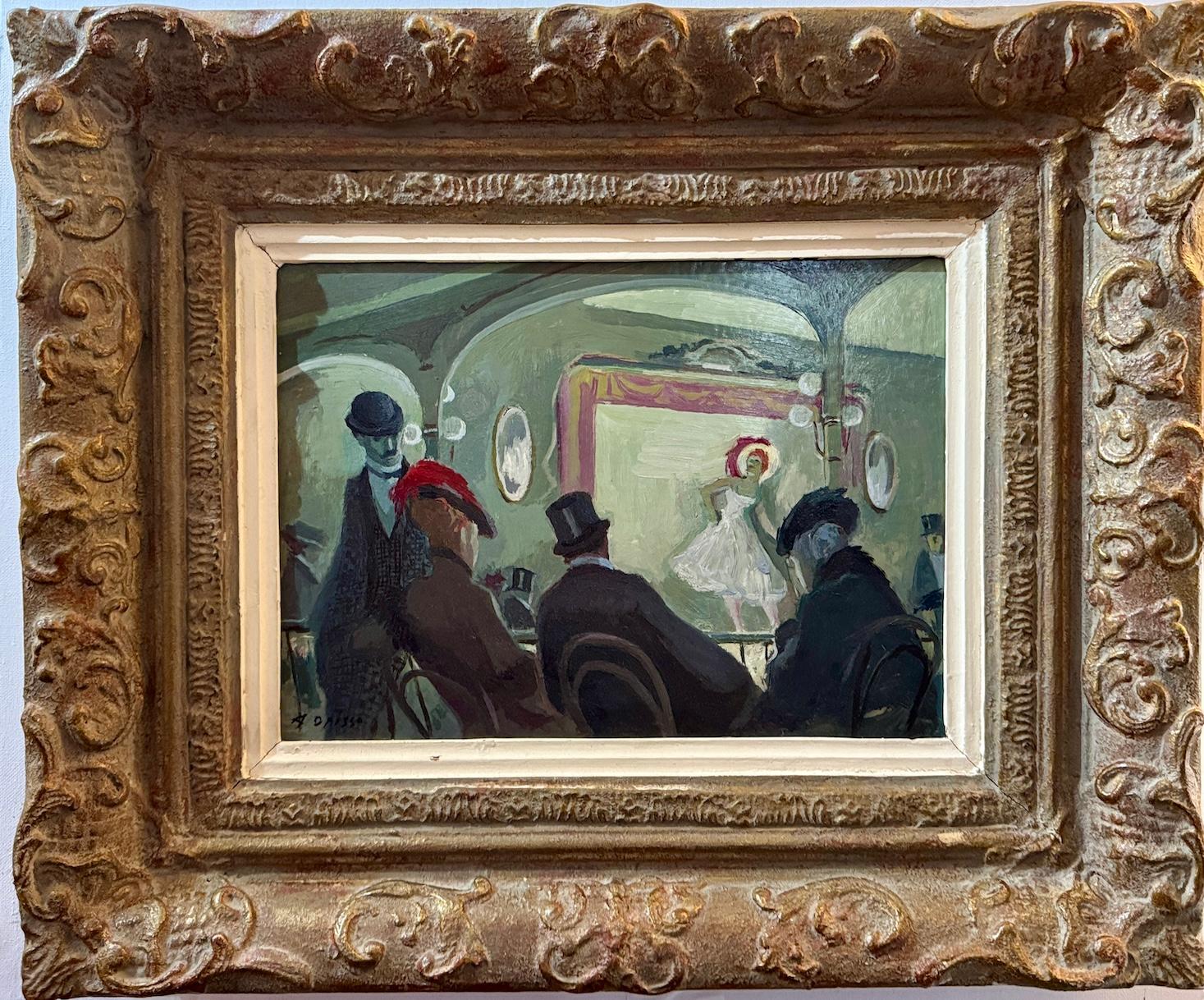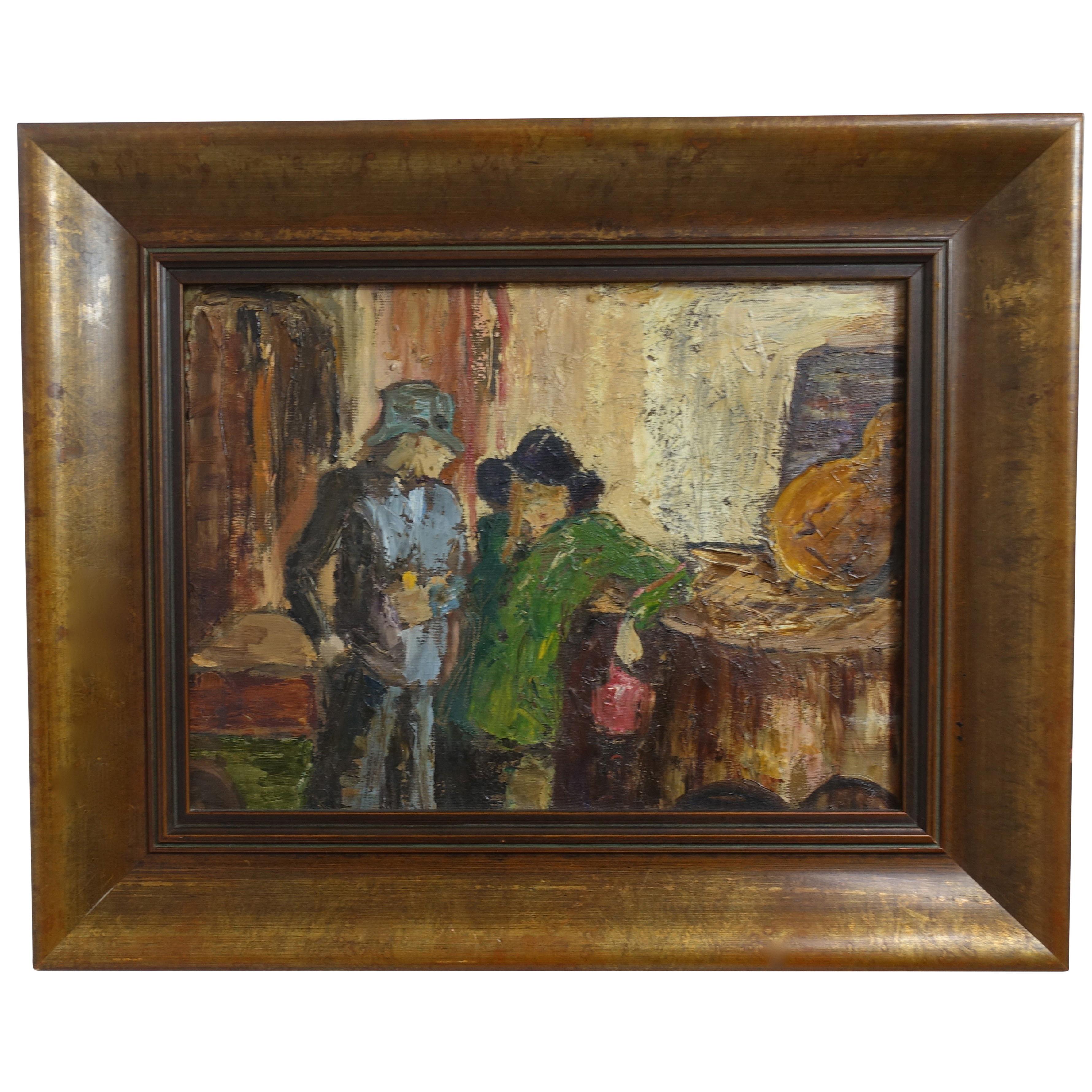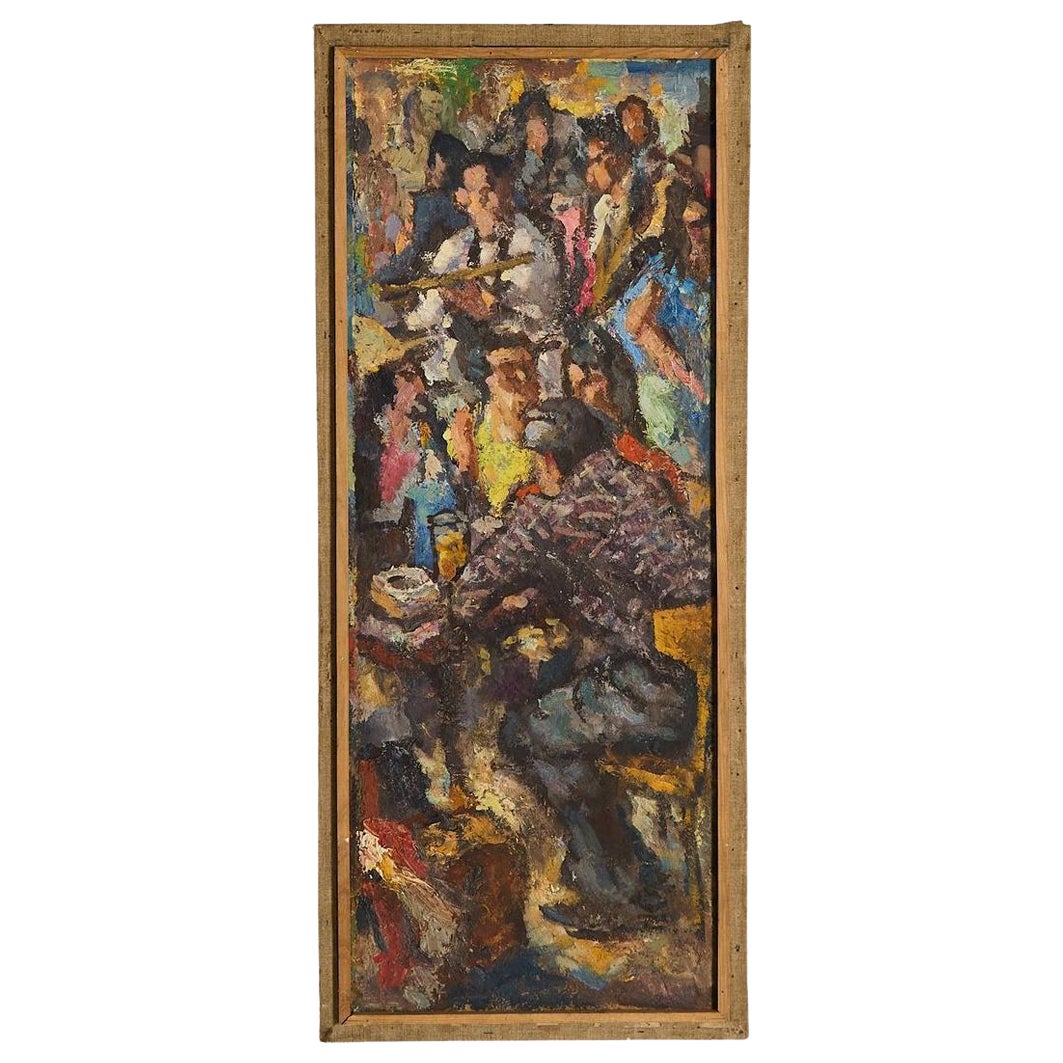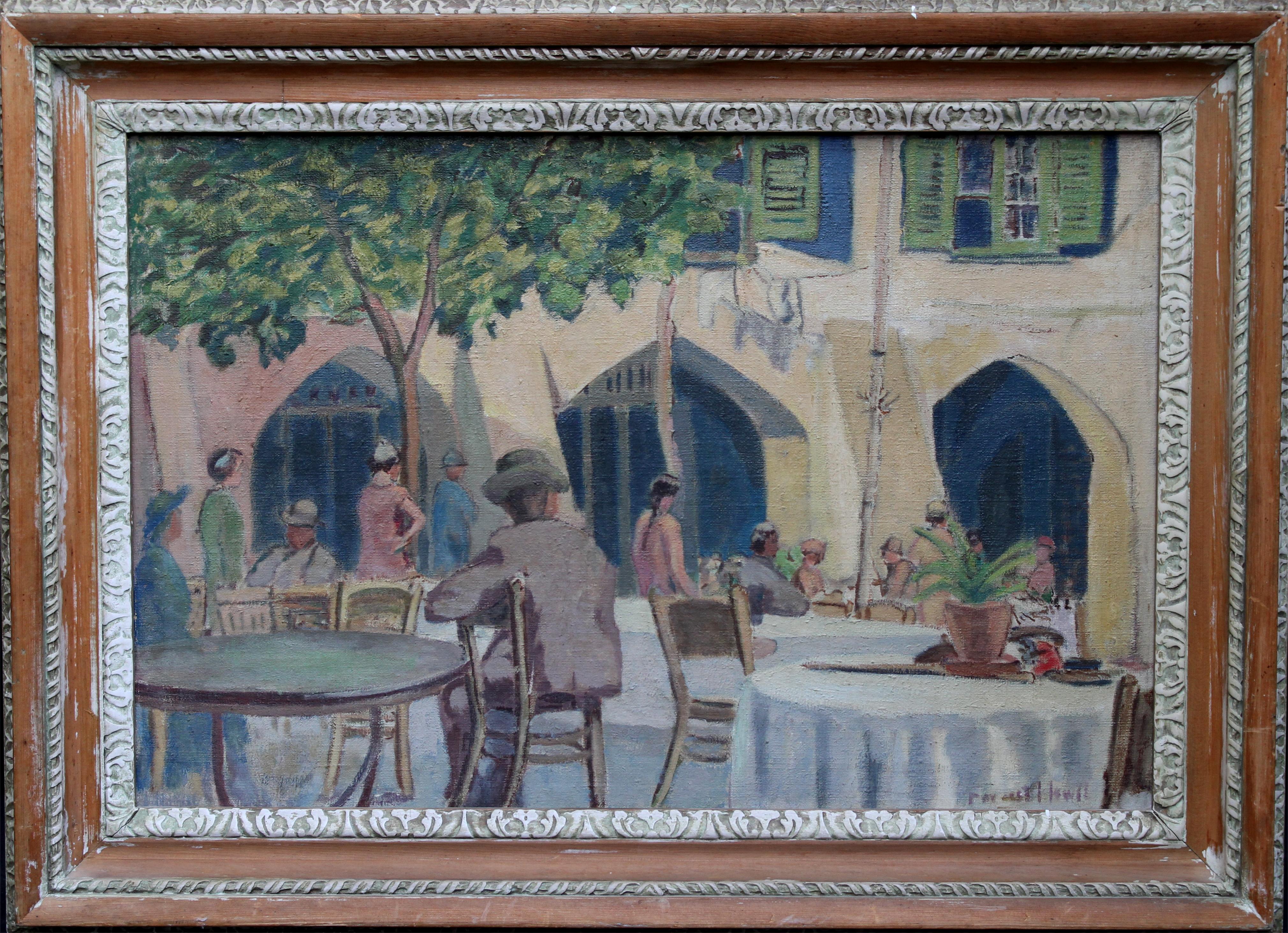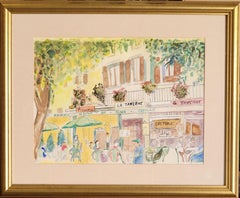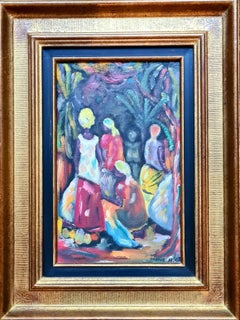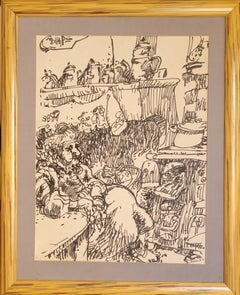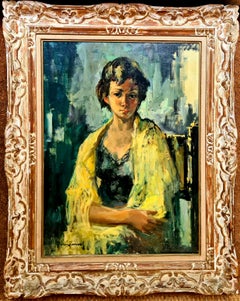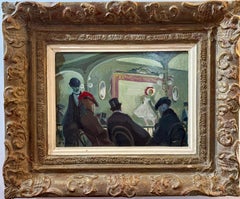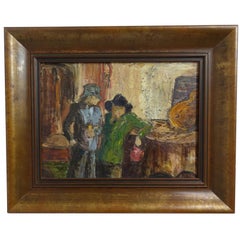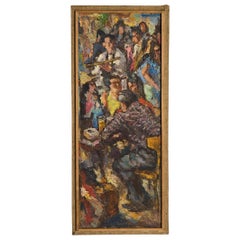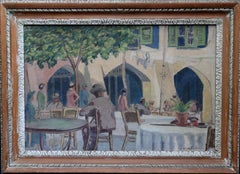Items Similar to Post Impressionist Bar Scene, Le Cafe du Commerce, Oil on Board
Video Loading
Want more images or videos?
Request additional images or videos from the seller
1 of 14
Simon Simon-AugustePost Impressionist Bar Scene, Le Cafe du Commerce, Oil on Board1930s
1930s
$2,496.20
£1,871.72
€2,100
CA$3,483.12
A$3,771.20
CHF 2,004.97
MX$45,483.28
NOK 25,213.67
SEK 23,506.32
DKK 15,998.02
About the Item
Early 20th Century oil on board interior bar scene by Simon Joseph Simon-Auguste. The painting is signed bottom right and presented in a fine gilt carved wood Montparnasse frame. There is the outline of another drawing to the back board.
This evocative painting captures a woman seated at a café, her profile turned away in contemplative thought. Rendered with an Impressionistic flair, the painting employs a muted palette of blues, browns, and soft reds, and various glazes evoking a sense of introspection. The brushstrokes are loose yet deliberate, adding a dynamic texture to the woman's form and the bustling background figures. Unique to this piece is the juxtaposition of the serene subject against the lively café setting, which is conveyed through blurred figures in the backdrop, suggesting movement and chatter. The woman's red dress stands out, drawing the viewer’s eye and indicating an inner warmth amidst the cool tones of her surroundings. This contrast between subject and setting explores themes of solitude and reflection within a social environment, making the artwork profoundly engaging and thematically rich.
Simon Joseph Simon-Auguste (20 April, 1909 – May, 1987) was a French artist, known for his intimate paintings, mainly portraits, nudes, and still lifes. His production is characterized by a calm, intimate feel and the effective use of glaze.[a]
In 1931, Simon-Auguste finished his studies at the École des Beaux-Arts and won the Stanislas-Torrents award. He was commissioned to execute the mural decorations of the town hall in Allauch. He began exhibiting in Marseille where doctors and lawyers purchased his paintings.
In 1932, he invested into a 6-month stay in Paris, where he frequented the Louvre Museum and became specially interested in the Camondo Collection. At the invitation of art dealer Adolphe Basler, he took part in the Moins de trente ans exhibition, at the Galerie de Sèvres, along with Jacques Despierre, André Hambourg, Louis Dideron, Léon Couturier, among others. He presented a nude, a still life, and a view of the Jardin du Luxembourg. He also started dealing with Georges Petit and the Galerie Vildrac.
In 1933, Simon-Auguste had his first solo exhibition at the Galerie Detailles, at the Canebière in Marseille which contributed to his success. He displayed 40 pieces (paintings, watercolours, and sketches), mostly nudes and genre scenes.
Simon-Auguste returned to Paris after the Liberation in 1944, to take part for the first time in the Nationale with La Fillette aux Pommes.
In 1950, he was appointed member at the Salon d’Automne. This year he submitted Le Café du Commerce to the Grand Prix de la Peinture Contemporaine, at the Marsan Pavilion (Louvre Museum). He was amongst the 100 painters selected by the jury.
Also in 1950, the city of Paris acquired his Marine de La Rochelle. The Musée du Château de Sceaux acquired Paysage de l'Ille-de-France. The French state acquired La Fillette à la lampe in 1952, Nature morte aux Bleuets in 1953, and Comme un Poisson dans l’Eau in 1955.
In 1951, he contributed to an itinerant exhibition around Switzerland (Bern, Lausanne and Geneva) about Les fleurs et les fruits.
His works can be found in private collections and museums, such as the Musée des Beaux-Arts de Marseille, the Musée Cantini in Marseille, the Musée Carnavalet in Paris, and Musée d'Art Moderne de Paris.
- Creator:Simon Simon-Auguste (1909 - 1987, French)
- Creation Year:1930s
- Dimensions:Height: 25.2 in (64 cm)Width: 29.53 in (75 cm)Depth: 1.97 in (5 cm)
- Medium:
- Movement & Style:
- Period:
- Condition:With original glazes, some losses and wear to frame.
- Gallery Location:Cotignac, FR
- Reference Number:Seller: LG/Auguste1stDibs: LU1430216412052
About the Seller
5.0
Platinum Seller
Premium sellers with a 4.7+ rating and 24-hour response times
Established in 2000
1stDibs seller since 2020
286 sales on 1stDibs
Typical response time: 1 hour
- ShippingRetrieving quote...Shipping from: Cotignac, France
- Return Policy
More From This Seller
View AllFrench Café Scene. 'La Taverne'. Watercolour on Paper..
Located in Cotignac, FR
Late 20th century watercolour of a French street scene with café by French artist Raymond Lacouture. Presented in a gold wooden frame under glass.
This artwork presents a vibrant, l...
Category
Late 20th Century Landscape Drawings and Watercolors
Materials
Watercolor
Colourful Expressionist Fauvist Market Scene
Located in Cotignac, FR
Colourful Expressionist oil on canvas view of a market scene by A Monis. The painting is signed and dated bottom right and presented in a magnificent custom gilt wood frame.
Provena...
Category
Mid-20th Century Expressionist Figurative Paintings
Materials
Canvas, Oil
Mid-Century French Feutre on Paper. Tea time In the Kitchen.
Located in Cotignac, FR
Late Mid Century French feutre drawing on paper of a Provençal lady sitting in her kitchen by Jean Arène. Signed and dated bottom left.
This artwork is a striking pen-and-ink drawing that vividly captures a cluttered interior scene filled with an assortment of teapots and household objects. The central figure, an elderly lady with an expressive face, sits at a table surrounded by an overwhelming array of details. The artist uses bold, dynamic lines to convey a sense of chaos and charm, creating an atmosphere of cozy clutter. The composition’s intricacy draws the viewer's eye around the room, showcasing...
Category
1960s Expressionist Figurative Drawings and Watercolors
Materials
Paper, Felt Pen
Ecole de Paris, Post Impressionist Portrait of a Fashionable Young Woman
Located in Cotignac, FR
Mid 20th Century oil on canvas portrait of stylish young woman by the noted Franco Spanish artist Pere Modesto Luis Creixams. The painting is signed bottom left and presented in a ve...
Category
Mid-20th Century Post-Impressionist Figurative Paintings
Materials
Canvas, Oil
French Mid Century Oil on Canvas, Interior, La Famille, Circle of Henri Matisse
Located in Cotignac, FR
Les Nabis inspired French mid century oil on canvas of a family in an interior scene by Léon Nancey. Though not signed the painting was acquired directly from the artists atelier.
...
Category
Mid-20th Century Figurative Paintings
Materials
Canvas, Oil
French Mid Century Still Life, Tablescape, Nature Morte. Oil on Board.
Located in Cotignac, FR
Large scale mid 20th Century French, oil on board, still life, tablescape, interior view, by Claude Barthélémy. Signed bottom left, presented in fine carved wood and gilt frame, with...
Category
Mid-20th Century Realist Still-life Paintings
Materials
Oil, Board
You May Also Like
20th century Spanish Cafe scene with dancing and drinking figures in a bar
By Alfredo Opisso
Located in Woodbury, CT
This captivating mid-century Spanish painting by Alfredo Opisso immerses the viewer in the lively atmosphere of a café or bar, where figures gather to drink, sing, and dance. Rendere...
Category
1960s Post-Impressionist Figurative Paintings
Materials
Oil, Board
Impressionist Style Bar Scene Painting Signed P. Archer, circa 1940
Located in San Francisco, CA
Bar scene or music scene painting, oil on canvas in painted wood frame, mid-20th century. Signed on the back stretcher bar P Archer.
Category
Mid-20th Century Paintings
Materials
Canvas
Impressionist Painting of Parisian cafe scene, 1930s
Located in London, England
Wonderful impressionist impasto painting of Parisian cafe scene.
Oil on canvas and board. Original artist made frame.
Good art history on the label verso.
France 1930s.
H 91cm x ...
Category
Mid-20th Century French Art Deco Paintings
Materials
Canvas, Pine, Paint
Cafe Porto Fino - British thirties Post Impressionist art oil painting
Located in Hagley, England
This lovely Post Impressionist oil painting is by British artist Forrest Hewit. This vibrant work depicts an external café scene under trees, with a dozen figures seated or standing ...
Category
1930s Post-Impressionist Figurative Paintings
Materials
Oil
C1930 Impressionist Ashcan Original Painting of a Cafe Scene Oil on Canvas
Located in Port Jervis, NY
Impressionist view of a interior cafe with a chef and patrons. Colorful palette with a Ashcan style in the Painting created about 1930. Unsigned. Framed in what appears to be the ori...
Category
Vintage 1930s American Modern Paintings
Materials
Canvas, Hardwood, Paint
Israeli French David Azuz Naive Oil Painting Paris Bar Scene Colorful Fauvist
By David Azuz
Located in Surfside, FL
David Azuz (1942-)
Bar scene with five people, drinking and talking.
Hand signed lower left
Oil on canvas
Dimensions: (Frame) H 20" x W 23" (Canvas) H 18.5" x W 22"
Tel Aviv, 1942...
Category
20th Century Modern Figurative Paintings
Materials
Canvas, Oil
More Ways To Browse
Jacques Andre
Impressionist Cafe Scene
Jardin Du Luxembourg
Jacob Jordaens
Japanese Painting Girl
Judge Magazine
Lee Mullican
Lucien Victor Guirand De Scevola
Mose Bianchi
Nymphs Bathing
Painting Girl With Bird
Paul Oxborough
Playing Music Painting
Saint Peter Painting
Sevilla Painting
Simon Bolivar
Statue In Paintings
Used Cowboy Gear
